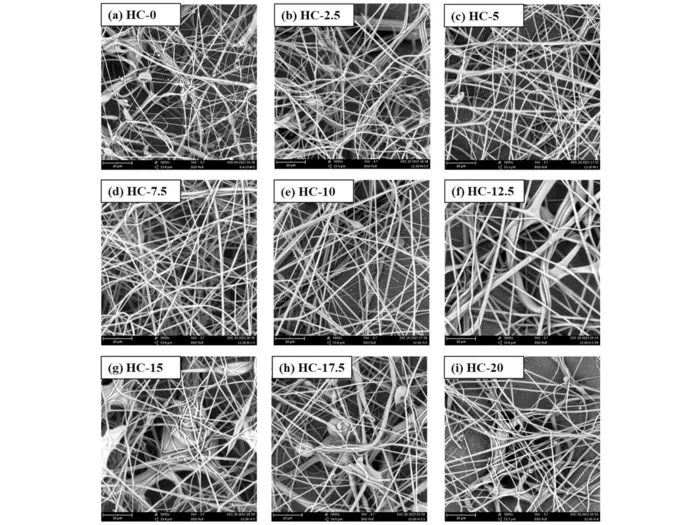UNIVERSITY PARK, Pa. – A groundbreaking study conducted by researchers at Penn State has uncovered the potential of milk protein and cellulose derived from plants to pave the way toward sustainable materials. This first-of-its-kind advancement hinges on the innovative electrospinning technique, which utilizes electric forces to transform liquid solutions into fine fibers. The researchers have successfully combined casein, a milk protein, with hydroxypropyl methylcellulose (HPMC), a plant-derived compound, to create nanofibers that measure about 1,000 times thinner than a human hair. This remarkable feat opens up new avenues for producing biodegradable and even edible food packaging materials.
The electrospinning process is intricate yet fascinating, involving the application of a high voltage to draw a liquid solution into a conical shape. As the solution is ejected from the nozzle, it stretches and transforms into extremely fine fibers. In this research, the investigative team effectively integrated casein with HPMC, producing nanofibers that exhibit desirable properties for a variety of applications, particularly in the realm of sustainable food wrapping technologies. The advancement signifies a significant step forward in combating plastic pollution, offering an eco-friendly alternative that is both functional and safe for food contact.
In a proof-of-concept study, Federico Harte, a professor of food science and one of the co-leaders of the research team, articulated the significance of the discovery: “We demonstrated the successful fabrication of stand-alone casein-rich electrospun mats.” This statement highlights the potential applications of protein-based electrospun nanofibers, which can not only be utilized for food packaging but may also play crucial roles in tissue engineering and biomedical applications such as wound dressings. The researchers’ innovative approach addresses a pressing need for sustainable food preservation solutions by leveraging naturally occurring proteins.
.adsslot_Ron91pfxKG{ width:728px !important; height:90px !important; }
@media (max-width:1199px) { .adsslot_Ron91pfxKG{ width:468px !important; height:60px !important; } }
@media (max-width:767px) { .adsslot_Ron91pfxKG{ width:320px !important; height:50px !important; } }
ADVERTISEMENT
Available online now, the study is set to appear in the forthcoming September issue of the Journal of Colloid and Interface Science. It meticulously details the experimental conditions that allowed the researchers to create fibers with minimal defects. Their findings revealed that a cellulose-to-casein ratio of 1:12 yielded fibers with the fewest beads—thickened, irregular sections that can compromise the effectiveness and integrity of the fibrous material—with the greatest surface area, making these fibers ideal for integration into mats.
One of the most intriguing aspects of this research is the discovery that at 100% relative humidity, the fiber mats undergo a chemical transformation when exposed to moisture, evolving into transparent films. This fascinating property suggests that the mats could serve dual purposes, functioning as effective food-wrapping materials while maintaining an attractive aesthetic. Such functionality could revolutionize how we think about packaging and food storage while adhering to environmentally conscious practices.
The application of casein as a foundational material is notable; this protein has a long-standing history across various industries, significantly enhancing food textures and nutritional values. Gregory Ziegler, the other co-leader of the research team and a distinguished professor of food science, elaborated on the significance of the study: “This research adds to its utility by giving a new form: nanofibers.” This statement underscores the multifaceted uses of casein and demonstrates how innovation can expand the functionality of common materials.
Over the years, there have been numerous efforts to explore the electrospinning of casein, marking this study as part of a larger narrative aimed at refining and improving the properties of casein-based materials. Previous research initiatives undertaken by the same team focused on electrospinning casein in isolation or in conjunction with carrageenan, another biopolymer primarily used in the food industry. Despite those earlier attempts, the resultant mats produced were weak and brittle, necessitating further investigation into enhancing the structural integrity of the fibers.
The introduction of hydroxypropyl methylcellulose as a supplement to the casein solution emerged from well-founded hypotheses about how cellulose might interact with protein to improve mechanical properties. As Harte pointed out, the decision to experiment with the addition of HPMC stemmed from the group’s realization that the initial formulations were not optimal in terms of performance. The fruitful collaboration between these two biopolymers demonstrates the exciting possibilities inherent in material science and engineering.
Future research endeavors are anticipated to delve into exploring diverse applications for these innovative, edible casein nanofibers. As their research indicates, there is a potential for integrating these nanofibers not just in food packaging but also in filtration systems, which could further broaden the product’s utility. The intersection of sustainability and technology in this area may well lead to a paradigm shift in how we approach material consumption, promoting practices that prioritize environmental welfare.
The promising aspects of this study highlight an essential connection between academic research and real-world applications, emphasizing the need for continued exploration in sustainable materials. With the backing of the National Dairy Council–Dairy Management Inc., the research team is poised to advance their research, ensuring that the sustainability conversation remains at the forefront of scientific inquiry.
In summary, this research opens doors to sustainable alternatives that can address global challenges concerning waste and pollution. The innovative coupling of milk protein with plant-derived materials offers a pathway to developing better food packaging solutions, aligning with the growing demand for bio-based and biodegradable materials. The implications of this study extend far beyond the laboratory, launching us into a future where our environmental footprint can be significantly reduced through the intelligent design of materials.
The scientific world eagerly anticipates the publication of these findings, as they not only add to the burgeoning field of bioengineering but also inspire hope in transitioning to a more sustainable future through applied sciences.
Subject of Research: Cells
Article Title: Fabrication and physicomechanical performance of casein-hydroxypropyl methylcellulose nanofibers
News Publication Date: 18-Apr-2025
Web References: DOI Link
References: Journal of Colloid and Interface Science
Image Credits: Penn State
Keywords
Tags: biodegradable solutions for packagingcombating plastic pollutioneco-friendly food wrapping solutionsedible biodegradable materialselectrospinning technologyfood safety in packaginginnovative materials from caseinmilk protein cellulose fibersnanofiber production techniquesPenn State research advancementsplant-derived packaging alternativessustainable food packaging





